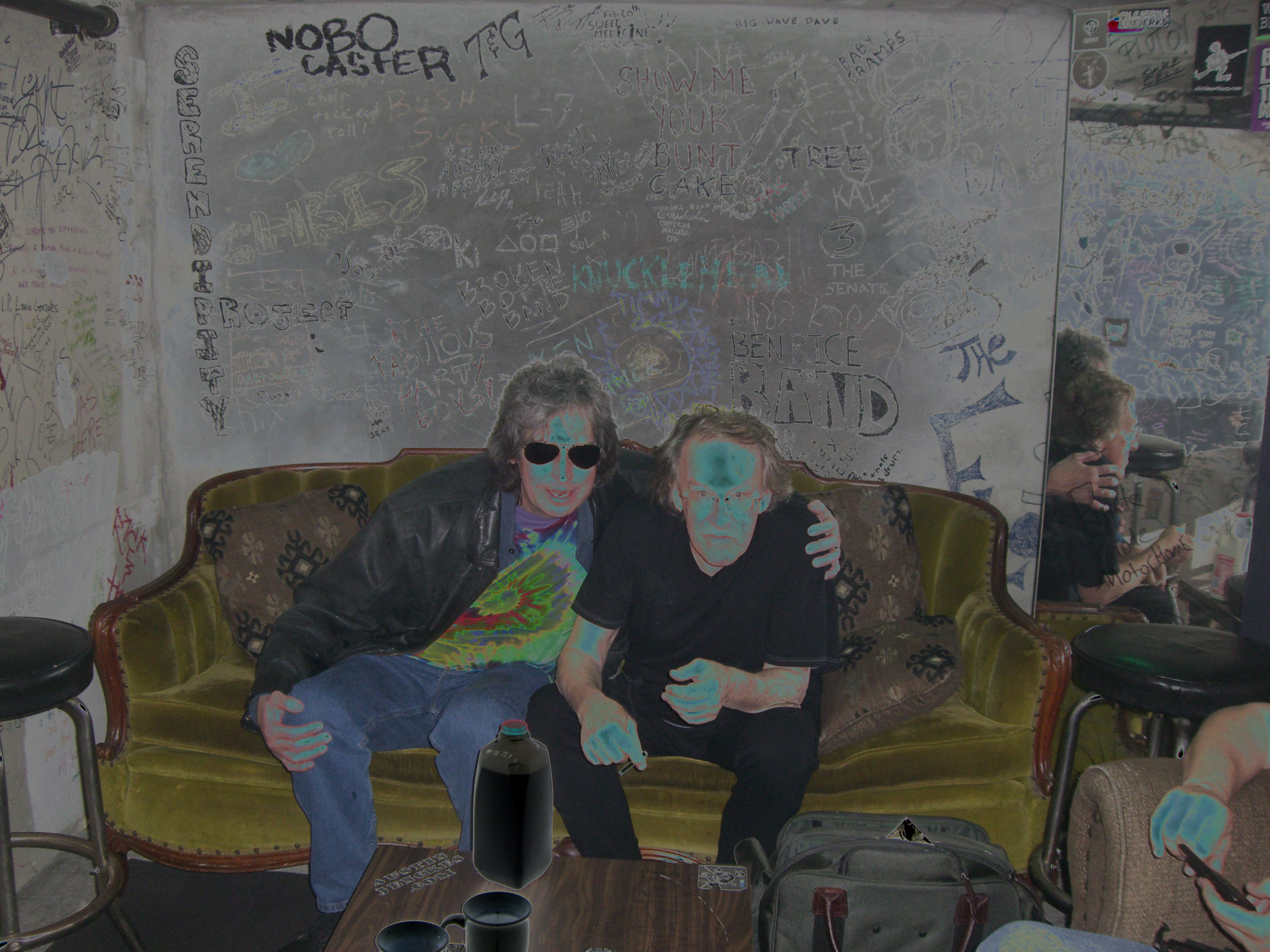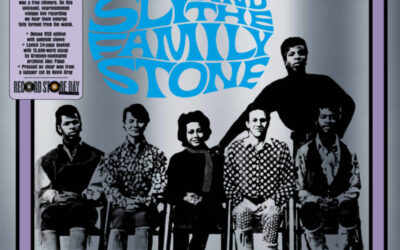By Harvey Kubernik c 2015
Singer and songwriter Marty Balin the founder of Jefferson Airplane, hit maker of the Jefferson Starship group, and a well-received solo career, is 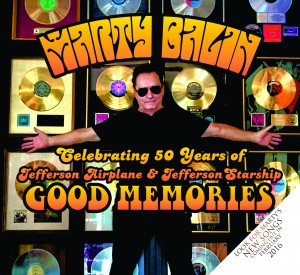 readying a new album, The Greatest Love for February 2016.
readying a new album, The Greatest Love for February 2016.
The collection, produced by Balin and Joe Vertino, was recorded at Marty’s Purple Paradise studio. Joining vocalist and guitarist Balin is upright bassist Lloyd Goldstein and lead guitarist Chuck Morrongiello. The album can be pre-ordered now through Martybalin.com.
During 2015, Balin released a double CD package, Marty Balin Good Memories, which celebrates 50 years of Jefferson Airplane and Jefferson Starship.
Marty’s classic trademark vocals can be heard on new renditions of his Jefferson Airplane and Jefferson Starship-penned tunes, now re-recorded with playing partners Goldstein and Morrongiello: “It’s No Secret,” “She Has Funny Cars,” “Today,” “Comin’ Back to Me,” “My Best Friend,” “Caroline,” “With Your Love,” “Runaway,” With Your Love,” and “Miracles,” among them.
Born Martyn Jerel Buchwald in Cincinnati, Ohio, on January 30, 1942, Balin moved to the Bay area at age four by parents Joe and Jean Buchwald. Joe was a lithographer, and printed more than 200 different posters for music shows at the Matrix club, the Fillmore and Avalon ballrooms. He briefly attended San Francisco State University; initially pursuing a career as a painter. He then turned to music with the encouragement of his good friend Ralph Mathis, brother of singer Johnny Mathis.
In 1962 Marty renamed himself Marty Balin and began recording with Challenge Records, recording at the legendary Gold Star studios in Hollywood with the area’s top session players. “Nobody But You” and “I Specialize in Love.”
He subsequently became lead singer of a folk music quartet called the Town Criers, followed by a brief stint with the Gateway Singers in 1965.
Marty then mulled over an electric folk sound. “I wanted to play with electric guitars and drums, but when I mentioned that notion in clubs that I played, the owners would say, ‘We wouldn’t have you play here. Not with drums and electricity. This is a folk club.’ So I decided to open my own club.”
Balin opened the Matrix on August 13th 1965 featuring his new band Jefferson Airplane. Over the next two years, Big Brother & the Holding Company, the War Locks, and the Doors would play inside his venue.
“Marty is the one who started the San Francisco scene,” said former Jefferson Airplane and Jefferson Starship manager, and Balin roommate, Bill Thompson.
“Back in those days Marty was quite the businessman,” stated Jefferson Airplane’s Paul Kantner. “He was the leader of the band on that level. He was the one who pushed us to do all the business stuff, orchestrating, thinking ahead, looking for managers and club opportunities. He was very good at it.
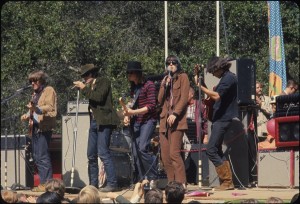 “We had the fortune or misfortune of discovering Fender Twin Reverb amps and LSD in the same week while in college,” Kantner revealed to me in a 2010 interview we did in San Francisco. “That’s a great step forward. (laughs). We later named a music publishing company Ice Bag which had nothing to do with cocaine. It was good marijuana. The best of the year if not the decade.
“We had the fortune or misfortune of discovering Fender Twin Reverb amps and LSD in the same week while in college,” Kantner revealed to me in a 2010 interview we did in San Francisco. “That’s a great step forward. (laughs). We later named a music publishing company Ice Bag which had nothing to do with cocaine. It was good marijuana. The best of the year if not the decade.
“FM radio was one of the many things that showed up and was going on in those days. So many things were going on you didn’t take that kind of notice of them. You just assumed that was going on. All right! And go with it.
“We didn’t analyze it. We didn’t think to wonder about it. It was just another thing that was going on along with the music, the clothes, the book stores, the poets, the artists, there was a plethora of things and you did not have time basically to take it all in. It existed. It’s part of a whole. In San Francisco we had no restrictions. All we had to do was roll with it. I liken it to white water rafting. There was so much going on you didn’t worry about what was around the next curve. Or what are you going to do on the third curve. ‘Cause you are right in the river.”
Initially a folk-rock venture, Jefferson Airplane came to epitomize the psychedelic scene that was reflected in their 1967 second album, Surrealistic Pillow.
Balin co-helmed the Jefferson Airplane/Jefferson Starship until the end of 1978. In 1981, he released his first solo album, Balin, which spawned the hit single “Hearts.” In 1989 he joined Jefferson Airplane for a reunion tour. In 1993 Marty reunited with Paul Kantner in Jefferson Airplane.
In the last few decades Balin has continued to make solo recordings and tour, now based in Florida.
Marty’s trio will be doing some dates in 2016 to support Good Memories and The Greatest Love. Shows are being set for New York in both March and May as well as Seattle in June.
Marty Balin was in Los Angeles this past November being honored at the Grammy Museum. While in town I interviewed him about Jefferson Airplane and his current performing group lineup.
Q: Living in San Francisco in the fifties and sixties, you saw a lot of local music before Jefferson Airplane really started flying.
A: I grew up and got to see all the beatniks and all the jazz cats in the clubs. I was a friend of Ralph Mathis, Johnny Mathis’ brother. They had a house in San Francisco. I’d go over with Ralph and Johnny would have Erroll Garner in there. Nancy Wilson, the Jazz Crusaders. And they’d just perform. And then Ralph and I would go downtown, ‘cause he was Johnny Mathis’ brother, we could get into any club. I saw John Coltrane. Man, I saw Miles Davis. I saw Thelonious Monk. Plus, I saw all the great writers and poets. This is a world before 1967 and the Summer of Love. It started with the beatniks and poets.
“I think San Francisco was full of all these people who were talented and who were expressing themselves or their rights or playing music. And I think San Francisco has a lot to do with that. I don’t know if it’s the geomagnetic forces of the earth and the ocean but something went on there. It’s a lot different than the rest of the world.
In a 1966 interview with Hollywood-based Radio station KFWB Hitline magazine, Balin mentioned that “Haight Street is just like [London’s] Carnaby Street. Long hair, boutiques, ice-cream parlors, band sessions and plays in the park, pie fights-it’s just great.”
Q: Tell me about the Matrix Club.
A: I opened the Matrix Club in 1965 in San Francisco. Booked bands in 1966 and ’67. As a solo performer in 1964, ’65, I started to use a 12-string guitar with a pickup on it and wanted to use drums. I had played the Hungry I, The Purple Onion, The Jazz Workshop as a folk band group. I went back to get some jobs and no one would hire me because I was too loud. So after being turned down by everybody, I was playing a folk club.
“In the evening I would perform and these four nurses used to come who liked me. Then they started coming with their boyfriends and during the break I was sitting and talking to their boyfriends and they were all talking about investing this money they had together and didn’t know what to do with it. So I said, “Well give it to me.” And I said, ‘I’ll build a nightclub and I’ll put a band in it and you can have the night club and you can have the band.’ ‘OK.’
“I roamed around and went into this bar down on Fillmore that looked empty on a Friday night. Not many people in it. So, I came back Saturday night and there were very few people in the bar. So I went and told these guys I thought we could get that bar because it’s not doing great biz. So they went and they got the license from that guy and we started fixing it up and making it into the Matrix. As we were doing that people, you know, people were comin’ in lookin’ for places to play. The infamous Warlocks. Janis [Joplin]. All these other people were looking for places to play, too. So I had an immediate influx. And besides that, I had jazz guys playing, there, blues guys, cats from The Committee. They would do stand up. It took off right off the bat.
Q: Jefferson Airplane replaced Signe Anderson, the original female vocalist in the band, and Grace Slick joined the expedition.
A: Grace Slick was real popular at the time with her own band, The Great Society. She had her brother and her husband in that band. When we need to get a new girl, because Signe [Anderson] was pregnant and she didn’t want to tour outside San Francisco, so we needed the new girl.
“There were only three girls around singing: Janis in Big Brother, Grace with the Great Society and Lydia Pence of Cold Blood. Janis.
“I have heard people sing ‘Summertime’ by the thousands. I have never heard anybody do ‘Summertime’ like Janis. She sent chills up my spine and I’m standing on stage watching her do it. It was just amazing. I thought she was a great entertainer and just a fun person. People loved her.
“And I told the guys when we had this meeting I said, ‘Who can we ask? They all have big popular bands.’ So Jack [Cassady] said, ‘I’m gonna ask Grace Slick.” I kind of chuckled at that. She was pretty popular. But you know, Grace used to come to the Matrix and sit out in the audience, right in front of the stage and watch me. She would stare me down. She would just sit there. And Jack asked her that afternoon and that evening she left her band and joined us. Can you believe that? That’s amazing.
“It’s funny. When we were looking for a girl singer we actually auditioned [topless dancer] Carol Doda. We did. I cracked up. She came in and had this thing on Broadway as a topless star and I was amazed she actually came and auditioned. She couldn’t sing very well.
Q: On your new Good Memories you cut “It’s No Secret,” initially done for Jefferson Airplane Takes Off debut RCA LP.
A: In 1966, and ’67, and all through Jefferson Airplane, we did my tune “It’s No Secret.” I originally wrote it with Otis Redding in mind. It was for him. I used to hang out with Otis and follow him around like a little puppy dog and watch his shows. Hang out with the band and him. I just wanted to write him a song that had his kind of groove thing I thought. But Otis never did it. He did write his own songs. I didn’t discover Otis at the Monterey International Pop Festival.
“In fact, I was the guy who took the 45 record of Otis’ ‘These Arms Of Mine’ to Bill Graham. ‘Hire this guy. I want to see him.’ And Bill Graham did. December of 1966. He would listen to the bands of who to book and as support or lead acts. Otis was the most powerful person I’ve ever seen perform. Outside of anybody you name. I’ve seen a lot of people play and on TV. I’ve never seen anybody handle an audience like him and rock the joint. The energy level was amazing with this guy. He had that great horn section.
“For me a highlight of the Monterey International Pop Festival was Otis. I had been around and he knew who I was. We went on before he went on. And nobody got the crowd moving but when the Airplane came on we got the crowd moving. We got them excited and got ‘em up and dancing. And I walked off and Otis Redding was standing there and he said, ‘Hey man. It’s a pleasure to be on the same stage with you.’ For me, that was it, baby. Right there. He staggered the crowd.
Q: You worked with concert promoter Bill Graham, who in the sixties managed Jefferson Airplane for a while.
A: In my formative rock days, Bill Graham was my manager, and you couldn’t have a better teacher.
Bill came out from New York and had the New York moxie. He was a totally different cat. He was running the Mime Troupe when we went over there 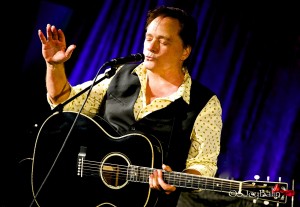 to rehearse and I remembered him. He was sitting in the office and I looked at him and remembered him auditioning for this play, Guys and Dolls. And he got fired after a big fight with the director. ‘Cause I was a dancer in the show. So I went into the office. And he asked, “‘I’m just playing original music. I just want to do that.” And we started talking and I said, “Why don’t you put on a benefit for your Mime Troupe and we’ll play it and see what happens.” And he put on a benefit for the group’s legal defense fund. They were lined up around the block. Lawrence Ferlinghetti, the Fugs, John Handy, and Jefferson Airplane. November 6, 1965. I said, “Hey Bill. Why don’t you get a place and we can play often?” So he went and got the Fillmore. We played a show with the Russian poet Andri Vozneskensy. And boom! History was made.
to rehearse and I remembered him. He was sitting in the office and I looked at him and remembered him auditioning for this play, Guys and Dolls. And he got fired after a big fight with the director. ‘Cause I was a dancer in the show. So I went into the office. And he asked, “‘I’m just playing original music. I just want to do that.” And we started talking and I said, “Why don’t you put on a benefit for your Mime Troupe and we’ll play it and see what happens.” And he put on a benefit for the group’s legal defense fund. They were lined up around the block. Lawrence Ferlinghetti, the Fugs, John Handy, and Jefferson Airplane. November 6, 1965. I said, “Hey Bill. Why don’t you get a place and we can play often?” So he went and got the Fillmore. We played a show with the Russian poet Andri Vozneskensy. And boom! History was made.
“I loved the room. There was a good sound system that changed and grew as the bands grew with their equipment. That’s one of the amazing things: The technology that grew around us, you know, as we were playing. Because I remember starting out we had these little Column speakers on the side of the stage that were really lame. Especially for electricity. And I thought to myself, ‘Boy. If it’s like this for me. What was it like for Little Richard and Elvis and guys like that?’
“As the Fillmore started, people were coming in with amps and guitars for the guys to try and a new sound system that was always be changed, being put up and getting bigger and better. It just all grew all around us and just fascinating to watch.
Sidebar
In 1998, I interviewed Grace Slick and asked her about Graham and his Fillmore room.
“As a rock ‘n’ roll force, I mostly liked his energy. Both physical and mental. He was able to keep an awful lot of balls in the air. He could organize, and do business, whereas most of us were on the artistic side, which is a positive thing, but also we would not have been able to deal effectively, I don’t think, with the business end of it. Which he did. And without that, we would not have had what we did. A venue to express ourselves.
“The audience and the bands were not that separate. In other words, a large amount of the audience was the other bands at the time. There were lots of bands that were working in San Francisco and we played with each other on the stage sometimes. Somebody would walk up from the audience and play guitar for a while with somebody. Another band. So it was casual, and not that separated. Also as Paul said, and it’s true, there’s more room on the stage.
“Marty is also very strong as a combination singer and performer. When he wasn’t with us and I was singing alone on stage I felt hammy. There was no additional pressure being the focal point, it was just boring. There’s nobody I want to listen to for two hours. My sarcasm and Paul’s political stuff over and over. Marty really loves R&B. It used to be very underground to say ‘let’s storm the walls.’ You learn over the years that love is probably the only thing that everybody gets off on.
End Sidebar
Q: The Jefferson Airplane had a traveling light show. I know you said the songs could work on stage without that visual component. Was it an essential component in bringing the message and the sound to the audience?
A: You can see us and the light show in the Monterey Pop movie. The light show was important. There were times we played in a museum and the light show would be the main thing and they would turn the lights out on us on stage so that we would be in shadow so they could just concentrate on the light show. ‘Cause it was getting talked about more than anything else at the time.
“It was a lot of fun. I used to go up and play with the plates. I remember when Jimi Hendrix played the Fillmore and we were playing with him for a few dates and I went up and played the plates when he was on. I’d start working the light show.
Q: The Doors played the Matrix club in very early 1967. I know in ’67 and 1968 you toured the U.S. and Europe together.
A: I didn’t see the Doors at the Matrix Club but saw them many times. We worked and played with them many times. We did some high school and colleges shows together. I loved the Doors. Oh my God! I thought Jim Morrison was fantastic. I fortunately became a friend and hung out and got to drink with him. He’d read me his poems all the time. I thought that was funny. I thought Jim was great as an artist. Who knows? He would have probably gone into film and done movies. The guy was a good lookin’ dude, man. I’d go out with him and try and pick up chicks and I was like invisible.
Q: How was “Comin’ Back To Me” from Jefferson Airplane’s Surrealistic Pillow written?
A: It just happened. I left the RCA studios in Hollywood and went back to the motel I ran into Paul Butterfield and they had this joint and gave it to me. “Smoke this Marty. It’s the best stuff you’ll ever smoke.” (laughs). So I did. And I was in my room and I tell you, I couldn’t find my legs. I got up and went to the guitar. Bam! In five minutes that song came out. So I ran back to the studio, the session pretty much ended, they were cleaning up. Jerry Garcia was there, Grace and Jack Cassidy. And I said, ‘Hey guys. Play this with me.’ And I told the second engineer to torn on the tape and we did one take and that was it. And I didn’t think any more of it. Because you couldn’t play it live because it was so soft. I didn’t have any idea about that song lasting that long. It’s ended up in a movie and I’ve done it on my new album.
Q: There is also “Today.” Recorded originally for Surrealistic Pillow and re-done on “Good Memories. What do you remember about the writing or recording it?
A: I loved that RCA studio in Hollywood. We had a lot of studio time. The label would pull us off the road and say, “we need a new album.” One time when I wrote “Today.” Studio A had the Rolling Stones and Studio B was the Airplane and Studio C was Tony Bennett. The Stones and us wanted to meet Tony Bennett.
“So I thought the best way I could meet him was write him a song. So I wrote today and took it to the drummer who was working on that session. I gave him a tape of it. The engineers were great. Al Schmitt was top dog. He was great. He and his brother Ritchie were great people.
“In 2015 I sing ‘Today.’ I do it on my own. I don’t have any of the singers. I do a little trio thing. I would go out and do sessions and do songs, with orchestras, and every time I would do a song that way, people would respond with, ‘You know Marty. I liked it just with you and your guitar.’ So that’s what I started doing. Playing on my own. My buddy the guitar player said, ‘Hey. Can I play with you?’
“Then we met this bass guy. And he started playing with us. And you know, it’s really nice this way. We don’t have a bunch of egos. I can move the set the way I want. I go out and play two and a half or three hour shows. I go anywhere I want. Somebody calls out an old Jefferson Airplane song. ‘Yea. Let’s do that.’ I don’t have to wait for people to change their guitars or smoke a cigarette or have a drink or complain about the sound system. Me, I just go and do 40 songs in one show. I don’t have a guitar break in every damn song. I don’t have to wait for anybody else. I keep it moving. There’s a lot more space on stage.
“Now I write songs and eventually sing them, I can take a melody line or the song structure and I can move it wherever I want. There’s nobody else singing and no one else playing. So I have all that space to work with. Which really opens it up quite a bit. And make it much more powerful. In the long run you don’t have it all watered down with a lot of sounds filling up the space. In music it’s the spaces you leave open. I recorded ‘She Has Funny Cars’ the way it was written. Just me and a guitar with a little embellishment.
Q: Why does the music of 1967 still resonate so strongly this century and this decade?
A: As far as the music of 1967 still having power and reaching people in 2015? I put together a recent album Good Memories” Celebrating 50 Years of Jefferson Airplane and Jefferson Starship. They are good songs that people grew up with, you know. I’ve had people tell me they were married to one of my songs, their father died the year of one of my songs, some soccer game in Boston they use “Volunteers” for their theme. I’ve just heard Bernie Sanders wants to utilize “Volunteers” in his campaign.
“You don’t think about whether a song will last. I think about every time I do it that it still moves me and takes me to the place I want to go. It puts me in a trance. That’s the way I write ‘em or why bother to play them for people?
“In the Jefferson Airplane somebody might give me a chord change and make something out of it and write a song to it. How can I sing to this? What kind of melody would I put to it. I get the idea where I’m going. Over the years I learned to get out of my way and let the words come. I don’t try to write it. I just try to transcribe what I hear in my head.
Q: Do you have a specific songwriting process?
A: Sometimes it will be a lyric I write out because I have some words I like. And then I sometimes play the guitar and play something and I will write to it. Or someone will come to me, ‘Hey man. I just came up with these changes.’ ‘OK.’ I’m like a little puppy. It’s a game I play with myself. ‘That’s interesting. I wonder if I can sing that?’
“I listen to the music and the song is telling me things. In a trance like [Bob] Marley. I kind of let the words come out. ‘What is it saying?’ As simple and as easy as it comes. The more you play something simple and direct like that it gets bigger, enlarges and increases. It’s very interesting.
Q: I would be remiss if I didn’t ask about your hit with Jefferson Starship, “Miracles.”
A: I was reading these Persian poets who had these poems about making love to a woman but they’re really talking about God. That kind of gave me this idea. And I had been involved with a living avatar Sathya Sai Baba. They called him the man of miracles. And so I started playing out came this thing and making love to a woman but also it was about God and I put it all together. I played it for the band and they kind of looked at it and went “I don’t know about that… There’s something wrong with that.” Nobody really liked it, you know. And I thought, “Gee…I don’t know. Maybe they’re wrong. I liked it. Fortunately for them…
Sidebar
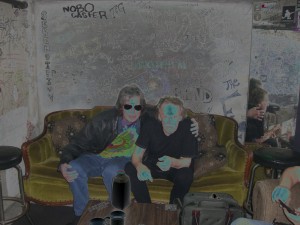
Cave Hollywood’s David Kessel in the green room with Paul Kantner at a Jefferson Starship gig April, 2011
In a July 1976 interview for Melody Maker, I asked Paul Kantner about Jefferson Airplane.
“I like bouncing ideas off people who like to work together. There’s a little magic in a band when people decide to put their heads and minds to one thing and it works. It becomes more than the people involved.
“Marty always says we could use more rehearsal. He would like to have the entire thing rehearsed, played and just about mixed before we hit the studio. We’re getting better toward a balance of spontaneity and perfection.
“Artists and people in general are watching out for the rain cloud. Some groups go through a phase that lasts five years. Some get a second wind. Good things come out of tensions. I like bouncing ideas off people who like to work together. There’s a little magic in a band when people decide to put their heads and minds to one thing and it works. It becomes more than the people involved.
“With the Airplane we thought we could do it all. It was a reaction against the corporate structure trying to impose certain limits on you. We revolted against that, which was the other extreme, which is doing it totally ourselves. And it was like putting a five-year-old in an automobile reeling down the street. It may make it down the street but the car may get a few dents along the way.”
End of Sidebar
Harvey Kubernik has been a music journalist for over 44 years and is the author of 8 books.
During 2014, Harvey’s Kubernik’s Turn Up the Radio! Rock, Pop, and Roll in Los Angeles 1956–1972 was published by Santa Monica Press.
In September 2014, Palazzo Editions packaged Leonard Cohen: Everybody Knows, a coffee—table—size volume written by Kubernik, currently published in six foreign languages. BackBeat/Hal Leonard Books in the United States.
Harvey and Kenneth Kubernik wrote the text for photographer Guy Webster’s first book for Insight Editions published in November 2014. Big Shots: Rock Legends & Hollywood Icons: Through the Lens of Guy Webster. Introduction by Brian Wilson).
In November of 2015, Back/Beat/Hal Leonard published Harvey’s book on Neil Young, Heart of Gold.

